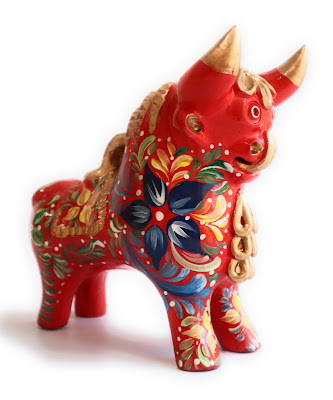HISTORY AND EVOLUTION OF THE PUCARA BULLS - TORITOS OF PUCARA
The Small Pucara Bulls also known as "Toritos de Pucara", are handmade ceramic sculptures created by local artisans from the southern part of Peru that take the silhouette of said mammal, and are adorned with a diversity of colorful strokes and flowers, each one with particular meaning. The production of bulls from Pucara has become a pottery tradition that is part of Peru's national heritage. The Pucara bull represents and is a symbol of protection, strength, vitality, prosperity, abundance and wealth.
 |
| Pucara Bull or Torito de Pucara |
This ceramic adopted the name of Pucara Bull due to the place where they were sold. In the past, the ceramic artisans of Pupuja exhibited their work in front of travelers at the train station called Pucara. Pucara was the closest place to the Pupuja community.
In the past, the priests of the Pucara Culture that developed on the northwest coast of Lake Titicaca in Puno practiced various rituals as part of the totemic wisdom, including the Andean ritual know as the "Señalacuy", which consists of identifying and placing a mark or adornment of cattle. In these rituals, stone effigies known as Conopa, Q'onopa or Illa (In Aymara language) were used, which were images of llamas and alpacas. These effigies were also buried in the animal pens as a protection and fertility amulet. Generally, offerings to the gods were placed in the cylindrical cavity of these amulets, which could consists of coca leaves, corn grains, precious shells and a mixture of animal fat.
 |
| Andean Ritual of Señalacuy |
History traces the origin of the Pucara Bulls to the time of the Spanish conquest. When the Spanish arrived in the Province of Pucara. During the Spanish conquest many Inca rituals were prohibited, Thus, the Incas sought acceptance by replacing the image of the llama with the image of a bull that was accepted by the Spanish. In this way, these amulets evolved into what is now called " Pucara Bulls" or "Toritos of Pucara"
The Spanish used to place spicy substances in the nose of the bulls in order to increase the animal's bravery, in response, the bulls stretched out their tongues to relieve irritation. The locals captured this fact in their ceramic work in a cheerful and mocking way.
 |
| Pucara bulls adorned with different designs |
Each Pucara bull is painted in different colors. Each color has a different meaning or each color is meant to attract luck in certain aspects of life. Thus, the white color symbolizes purity and protection in relationships. The color black symbolizes the ego and is more related to birth and fertilization. The color red represents protection and love at home. The green color means economic prosperity, fertility and good health. The blue color means trust, fidelity and friendship. The orange color means joy and fun. The natural color means protection to the family.
 |
| Each color of Pucara Bull has a different meaning |
Currently, families in Peru place two Pucara bulls on the roof of their houses as an amulet, to counteract bad energy and attract good luck and prosperity to their homes. The two little bulls represent the male and female Andean Dualism.
 |
| Pucara Bulls placed on the roof of Peruvian houses as an amulet |
The Pucara Bull has evolved over time, giving rise to different variations and versions in which different elements are added, such as images of crosses, stairs and symbols.
 |
| Special version of Pucara Bulls |
This special version of Pucara Bulls has particular features added such as cross, a ladder, keeping the belief that people should climb the stairs step by step in order to become more and more successful, in other words, the social and economic progress; a rooster, the animal that sings first thing in the morning, which means that things must be done in advance; and a crock pitcher that means enjoyment, friendships and parties as part of life itself, and that not everything is work in life.
Comments
Post a Comment